Menu
The Making of ‘Honky Château’
Elton John’s ‘Honky Chateau’ is a rich, warm, satisfying album that stands head and shoulders above the morass of current releases. … His best work to date and evidences growth at every possible level.
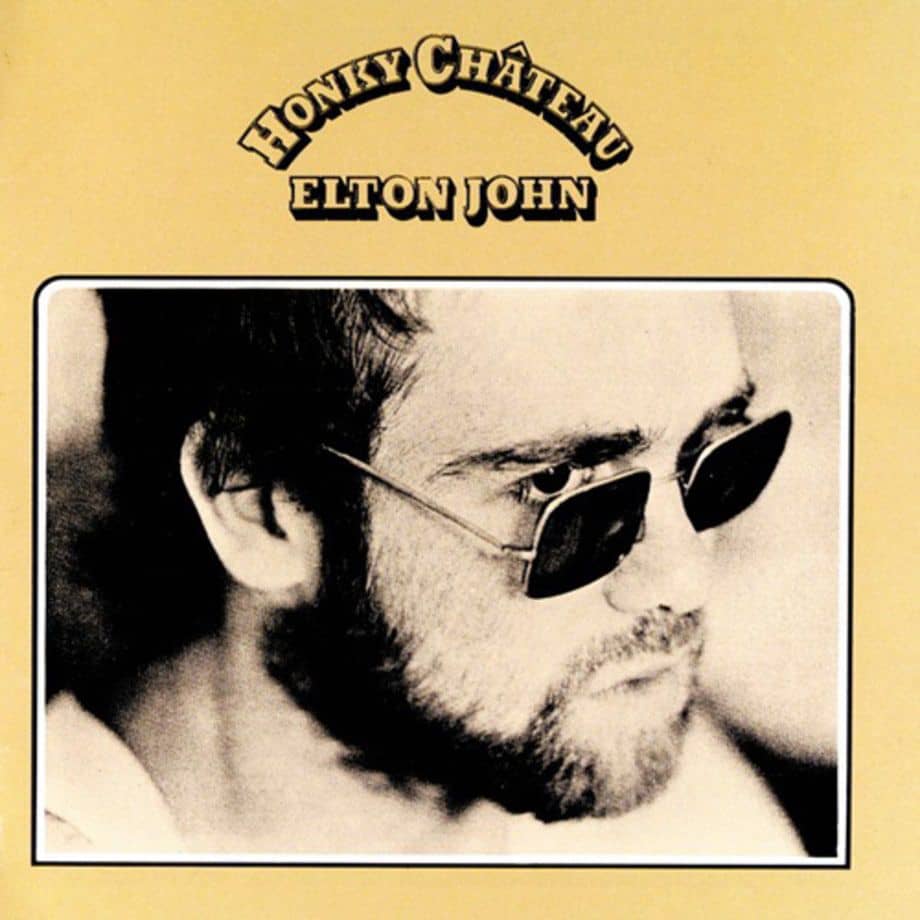
By John F. Higgins
As 1972 began, 24-year-old Elton John had already released four studio albums (six LPs overall) in just three years, each achieving increased success in both the UK and US. They had all been recorded in his native England and none of them had used his touring band members, drummer Nigel Olsson and bassist Dee Murray, on more than a song or two. Each was comprised of songs written over multiple years and all but one had been recorded in stops and starts. None had reached the top of the charts in any country.
This was all about to change drastically in early January when Elton and his band, now including guitarist Davey Johnstone, landed at Orly airport in France and motored their way to an 18th-century château-turned-live-in-recording studio roughly an hour north-west of Paris. The cramped environs of London’s Soho studios, Dick James and Trident, had been left behind for if not France’s bucolic countryside, it was the dead of winter after all, then at least a remote self-contained facility complete with a state-of-the-art 16-track board, its own living quarters, rehearsal space, and commissary/game room. And, rumor had it, a ghost or two.
Honky Château was written, rehearsed, and recorded between January 8th and 23rd, 1972, with the bulk of the sessions taking place over four consecutive days in the second half of the fortnight. There was only one day during which just one song was tracked: the album version of Slave, a slower interpretation of the originally “aggro” recording which Elton struggled to capture to his satisfaction, was laid down on the 23rd, during the time otherwise spent on over-dubs and final lead vocals.
For the first time in Elton’s career, the album’s songs were all written at the studio, often as the band members were waking up and making their way down to breakfast. Bernie’s freshly typed lyrics were waiting for Elton when he sat down at the food hall’s rehearsal piano to start each day, and before the meal had a chance to get cold a tune would be written and subsequently fleshed out by the band in anticipation of moving over to the recording studio the following week.
By the time we had gotten to the Château he was writing the whole album in five days. Then we'd probably rehearse it for about four days. And then we'd record it. So, it was as fresh as a daisy and sounds that way as a result.
January 15, 1972
★ SALVATION
Original LP: Side 2, Track 1
Musicians
Elton: piano, harmonium (uncredited) and vocals / Nigel Olsson: drums, backing vocals / Dee Murray: bass, backing vocals / Davey Johnstone: guitars, backing vocals / Madeline Bell, Tony Hazzard, Larry Steel, Liza Strike: backing vocals.
The first song recorded during the sessions, it includes no less than three layers of guitars, immediately showing off Davey’s multi-tracking skill set, four layers of backing vocals, and two for Elton’s vocals.
★ SUSIE (DRAMAS)
Original LP: Side 1, Track 4
Musicians
Elton: piano and vocals / Nigel Olsson: drums, tambourine, cow bell (uncredited) / Dee Murray: bass / Davey Johnstone: guitars.
Originally Black-Eyed Suzie, a conflict with a traditional bluegrass song of the same name forced its title to be adjusted, first to Pretty Little Black Eyed Suzie and eventually to the final version, with “(Dramas)” added as a comment on the situation. This song includes Davey’s first electric guitar solo on an Elton song and an overdubbed piano part by Elton, which is most noticeable underneath the second half of each chorus (“Living with her funky family…”).
January 16, 1972
★ ROCKET MAN (I Think It’s Going To Be A Long Long Time)
Original LP: Side 1, Track 5
Musicians
Elton: piano and vocals / Nigel Olsson: drums, backing vocals / Dee Murray: bass, backing vocals / Davey Johnstone: acoustic (Yamaha FG-140) and electric guitars, backing vocals / David Hentschel: ARP synthesizer.
The first song written for the album and Davey, Dee and Nigel’s initial attempt at backing vocals, resulting in great success. Gus explained one example of the system, “Once Nigel had done the top voice and got it strong, sometimes we’d say, ‘Well, why don’t we try Davey up there?’ It might be out of his range, but it would add a different color. So he wouldn’t have the strength, maybe, that Nigel had, but you already had that on tape. And then we’d do things like we’d say, ‘Well, why don’t we try some completely different harmonies? We’ve now got a three-piece harmony down, why don’t we try somebody doing the seventh on this note?’ And sometimes I’d have ideas and I’d go, ‘You know, I can hear this note…’ I mean, I can’t play [any instrument] so I’d go, ‘Can you play the tape?’ So, the guy played the tape and I’m going [sings, sort of] ‘Wooo! That note up there.’ So, it was like, ‘Oh, you mean … yeah, wait a second … yeah, actually that might work.’ Then Dee’d say, ‘You know, I was thinking, if you were going to do that I could do the fifth of that. And if Davey did the octave…’ It was a constant creative thing. Brilliant. They are unquestionably in my mind the best in-house backing vocalists that anybody’s ever had on record. I can’t imagine anybody could do a better job than those guys.”
Rocket Man has appeared on three of Elton’s live albums, four of his greatest hits compilations, and placed at No. 149 on Rolling Stone magazine’s list of 500 Greatest Songs of All Time in 2021.
To commemorate the song being selected as Honky Château’s first single, Elton and band visited the National Aeronautics and Space Administration (NASA) while on tour in Houston, Texas on April 28, 1972. They were given a tour of the facility by astronaut Al Worden, who had piloted the command module on the Apollo 15 lunar mission the previous year.
★ MELLOW
Original LP: Side 1, Track 2
Musicians
Elton: piano, organ and vocals / Nigel Olsson: drums, tambourine / Dee Murray: bass / Davey Johnstone: guitar / Jean-Luc Ponty: electric violin (through a Leslie speaker).
It was Marc Bolan who suggested using Jean-Luc Ponty. The violin solo on the recording was a first take, using a “regular” violin as opposed to the artist’s custom-made electric instrument. Gus: “[Ponty] then spent the next two or three hours trying to top it and didn’t get near it. I can remember Elton wandering around saying, ‘He’s so sweet!’, which he was.”
This is the album that both Elton John and Bernie Taupin have been threatening us with ever since the performing half of the duo escalated to [the] giddiest of heights. An extremely tasteful collection. A chart-topper if ever I heard one.
January 17, 1972
★ HONKY CAT
Original LP: Side 1, Track 1
Musicians
Elton: piano, electric piano, and vocals / Nigel Olsson: drums / Dee Murray: bass / Davey Johnstone: banjo / Jacques Bolognesi: Trombone / Jean-Louis Chautemps: Saxophone / Alain Hatot: Saxophone / Ivan Jullien: Trumpet / Brass arranged by Gus Dudgeon.
The brass section on this song was a “head-arrangement” by Gus, who could not read music. The challenge of communicating what he wanted to the four non-English speaking players proved difficult. “It took me about three or four hours of incredible gesticulating and very bad French to try and explain how you play like Muscle Shoals horns. You know, ‘Tongue-in…tongue-in the instrument.’ They didn’t understand that at all. I remember finishing at seven in the morning. Then it was double tracked – in fact, the solo in the middle is four trombones, but it’s just the same trombone playing the same part four times.”
★ MONA LISAS AND MAD HATTERS
Original LP: Side 2, Track 4
Musicians
Elton: piano and vocals / Dee Murray: bass / Davey Johnstone: mandolins, acoustic guitar.
A favorite of those involved in the making of this track, as well as Elton fans over the years. Davey explained in a recent Instagram that he “Stacked three tracks of mandolin [the multitrack list shows eight!] to achieve the shimmering sound reminiscent of the traditional Italian style. When I was recording this part Elton shouted, ‘Who ordered pizza?’ to the great delight of Gus, Dee, Nigel and [engineer] Ken Scott!”
★ SLAVE (fast version)
Take 8
Unreleased until Rare Masters (1992)
Musicians
Elton: piano and vocals / Nigel Olsson: drums / Dee Murray: bass / Davey Johnstone: electric guitars / David Hentschel: ARP synthesizer.
Originally written in the same speedy vein as 1971’s Rock Me When He’s Gone, the recording of this version had to be coaxed out of Elton by Gus Dudgeon. After some discussion later in the sessions, it was decided that the song would be re-recorded in a much slower style, resulting in the final album version.
The new, lighter, looser Elton John sound will not only prove satisfying to most of his earlier admirers, but may well go farther than anything since his first album in attracting new ones.
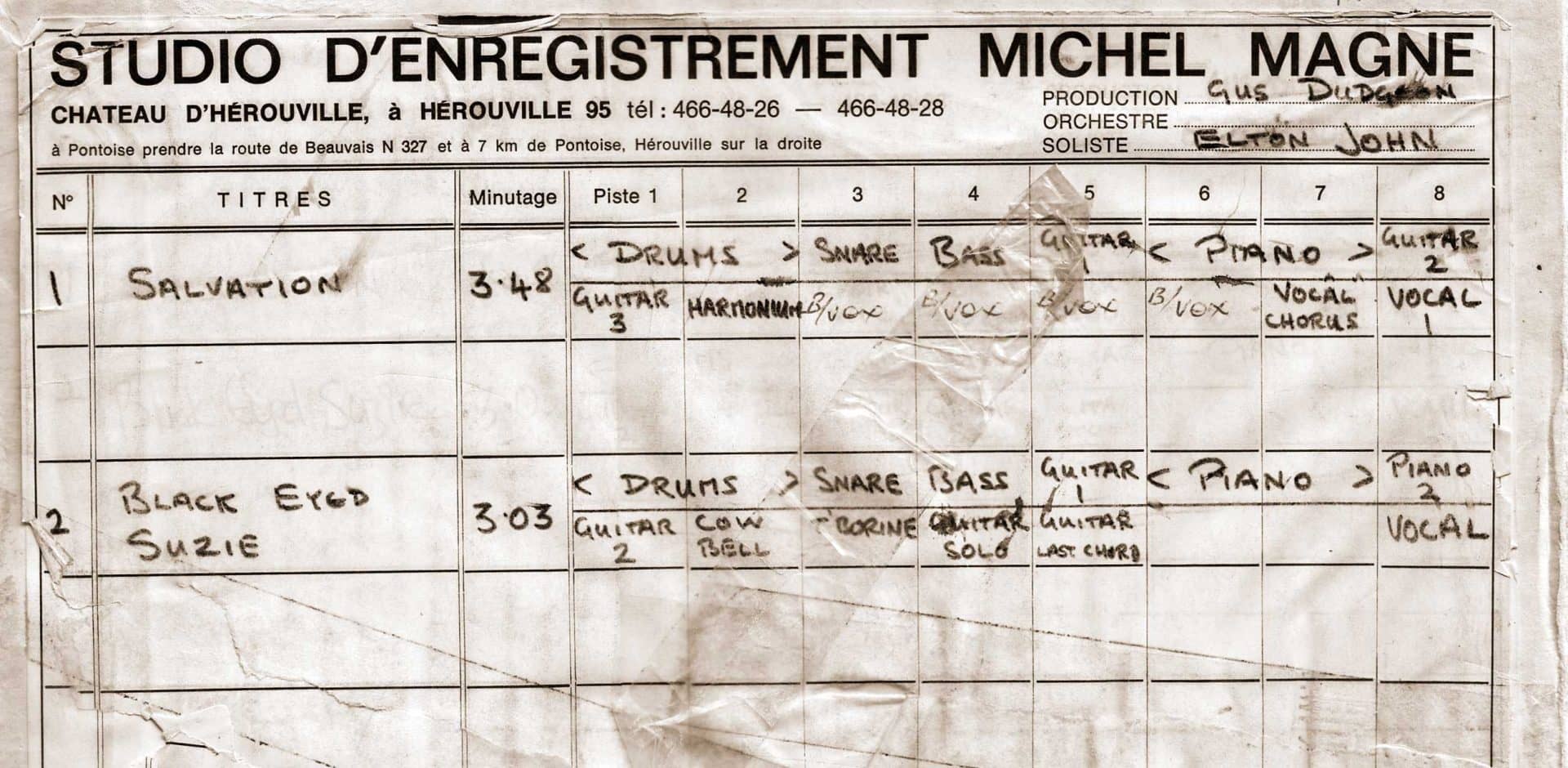
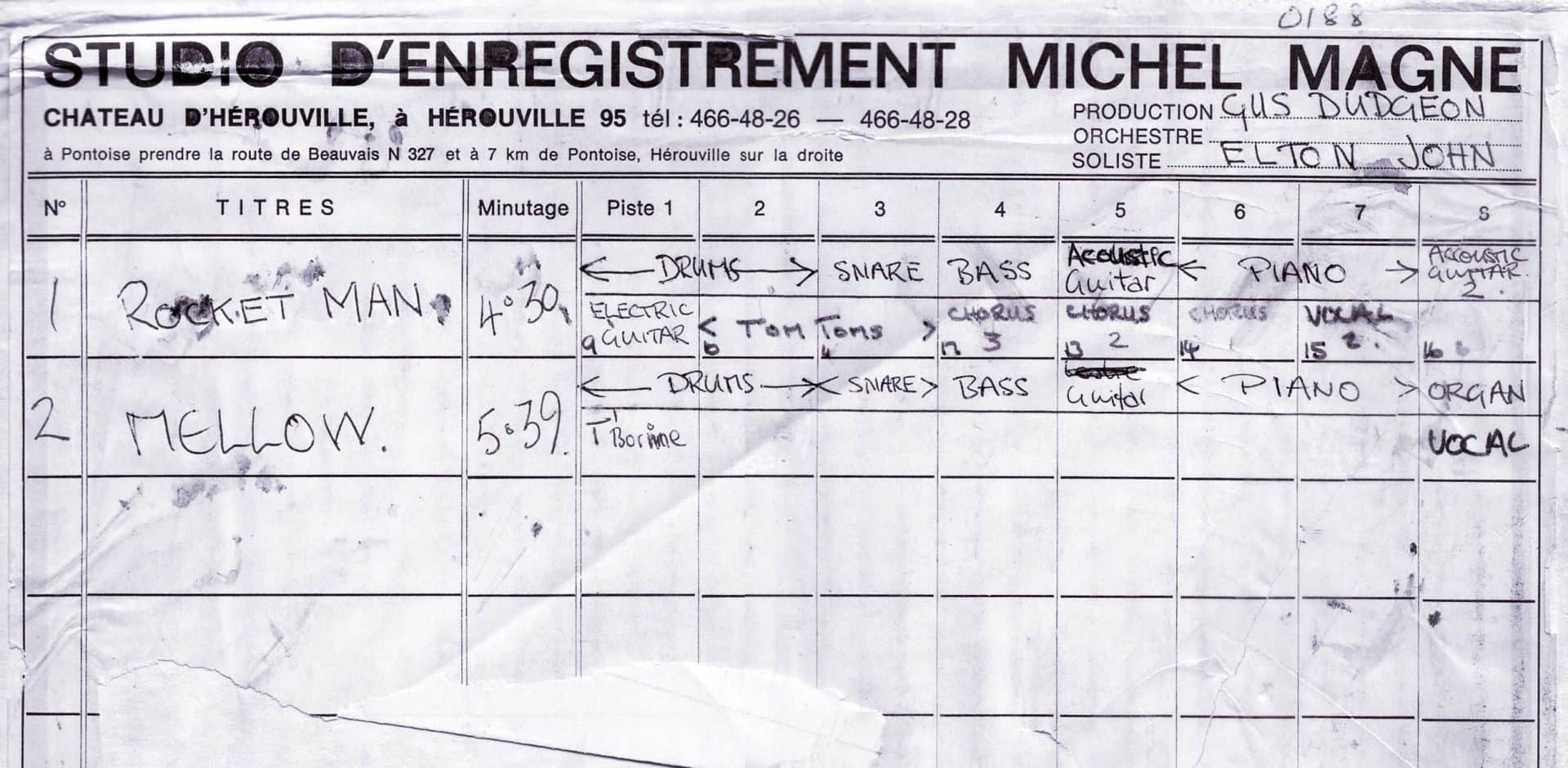
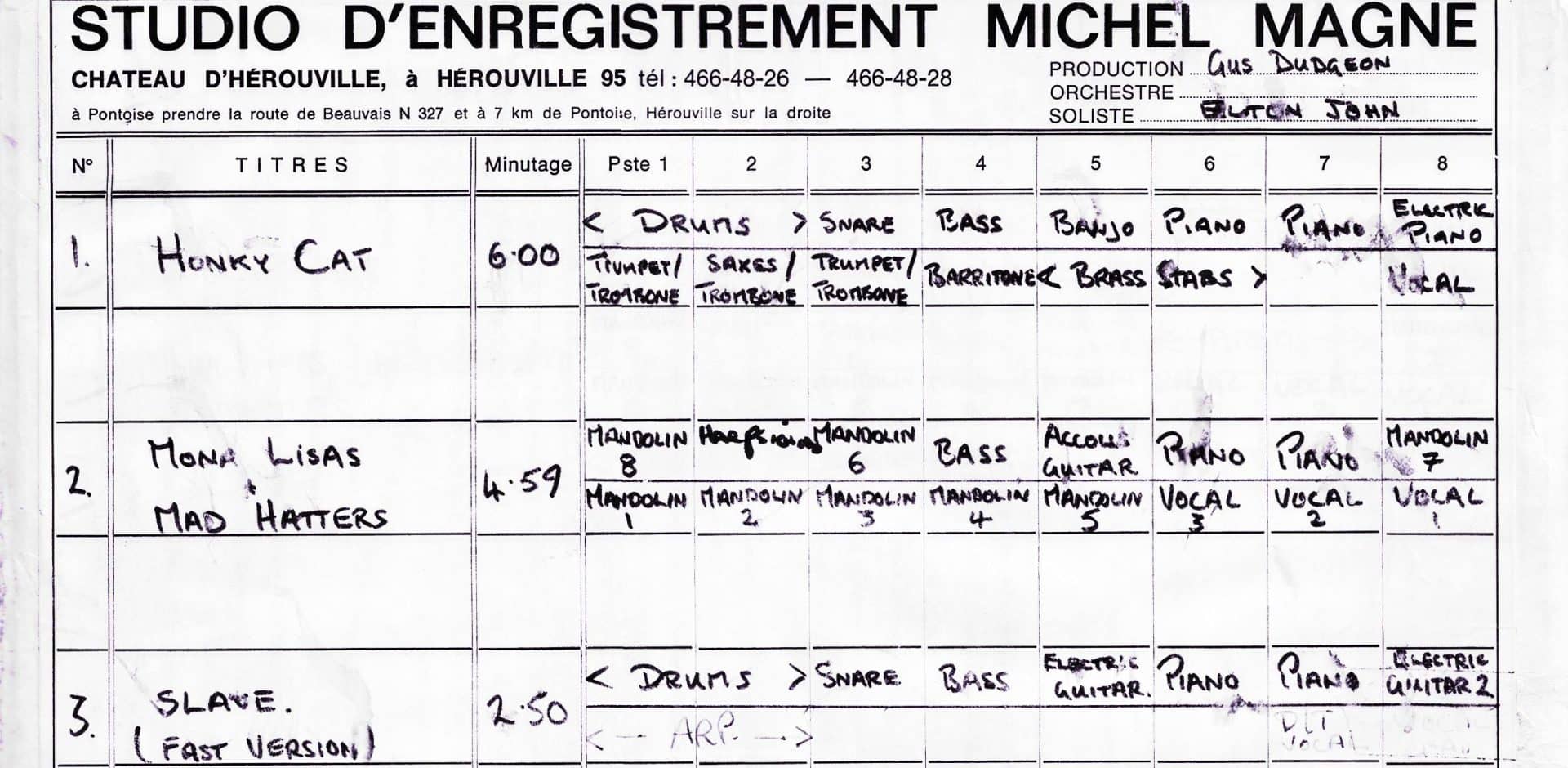
January 18, 1972
★ I Think I’m Going To Kill Myself
Original LP: Side 1, Track 3
Musicians
Elton: piano and vocals / Nigel Olsson: drums, tambourine (uncredited), backing vocals / Dee Murray: bass, backing vocals / Davey Johnstone: acoustic guitars, backing vocals / “Legs” Larry Smith: tap dance / Jean-Luc Ponty: violin (unused).
Gus: “I wanted to use Elton’s stepfather, Derf [Fred Farebrother], because he plays spoons [a traditional British folk music percussion instrument]. He wasn’t around so I thought, ‘Well, what’s the next best thing to spoons? Tap dance!’ I’d worked with the Bonzos [Bonzo Dog Doo-Dah Band] so I just called up Larry and he came to the studio and did the thing. I recorded him twice – on two separate tracks. That’s how come there’s such a wide stereo on it. It was two different performances. Elton said to me one day, ‘The stereo on Larry’s feet is incredible! How on earth did you get it so wide?’ So, I said, ‘Oh, we put a screen between his legs…’ I mean, as if anybody could tap dance with a screen between their legs! [Elton] was totally taken in.”
Fun fact: This is the first Bernie lyric to mention a pop-culture icon, Parisian actress Brigitte Bardot, setting the stage for many others in the future, like Marilyn Monroe, Roy Rogers, Robert Mitchum, and so on.
★ Hercules
Take 7 onwards, after an initial 6 tries earlier in the day
Original LP: Side 2, Track 5
Musicians
Elton: piano and vocals / Nigel Olsson: drums, backing vocals / Dee Murray: bass, backing vocals / Davey Johnstone: acoustic (Yamaha FG-140) and electric guitars, backing vocals / David Hentschel: ARP synthesizer / Tony Hazzard: backing vocals / Gus Dudgeon: rhino whistle, backing vocals.
Not only the name of this banger, but also Elton’s spontaneously self-selected middle name when he had legally changed his name just prior to the Honky Château sessions, as well as the name of his newly-purchased house in the swank village of Virginia Water in northern Surrey, England.
★ Amy
Original LP: Side 2, Track 3
Musicians
Elton: piano and vocals / Nigel Olsson: drums, backing vocals / Dee Murray: bass, backing vocals / Davey Johnstone: electric guitars, backing vocals / Ray Cooper: congas / Jean-Luc Ponty: electric violin.
Gus revealed that this song was written for his wife, whose name was in fact Sheila. “It’s actually not about my wife but my nickname for her used to be Amy. Elton said, ‘You know, I’d quite like to write a song for Sheila.’ And, I thought, ‘How sweet.’ She couldn’t wait for him to write this song and it turned out to be a song she can’t stand. I must admit, it’s not exactly one of my favorites.”
January 23, 1972
★ Slave
Original LP: Side 2, Track 2
Musicians
Elton: vocals / Nigel Olsson: drums, congas / Dee Murray: bass / Davey Johnstone: acoustic, electric and slide guitars, banjo.
It may surprise some Elton fans to learn that this is his fifth song to not have a piano or keyboard part (Elton was originally to have played electric piano on the track but did not).
RELEASE/CHART INFO
LPs
Honky Château was released on May 19, 1972, in the UK. It spent its first two weeks at the peak position of No. 2 on the UK Albums Chart and remained on the Top 200 for 23 weeks.
In the US, the album was released on May 26, 1972. It became Elton’s first of seven consecutive No. 1 LPs on the Billboard Top 200, sitting there for five weeks starting on July 15. It stayed on the chart for 61 weeks, by far the longest of any Elton release up to that time, and is currently at Platinum award status from the RIAA.
UK Singles
Rocket Man b/w Holiday Inn and Goodbye
Released on March 31, 1972, on DJM. Entered the UK Singles Chart on April 22 and peaked at No. 2 on June 3. Stayed on the chart for 15 non-consecutive weeks (two of those happening in 2007). Currently at 2x Platinum status from the BPI.
Honky Cat b/w Lady Samantha and It’s Me That You Need
Released on August 25, 1972, on DJM. Started on the chart on September 9, peaking at No. 31 on September 23. Remained on the charts for 6 weeks.
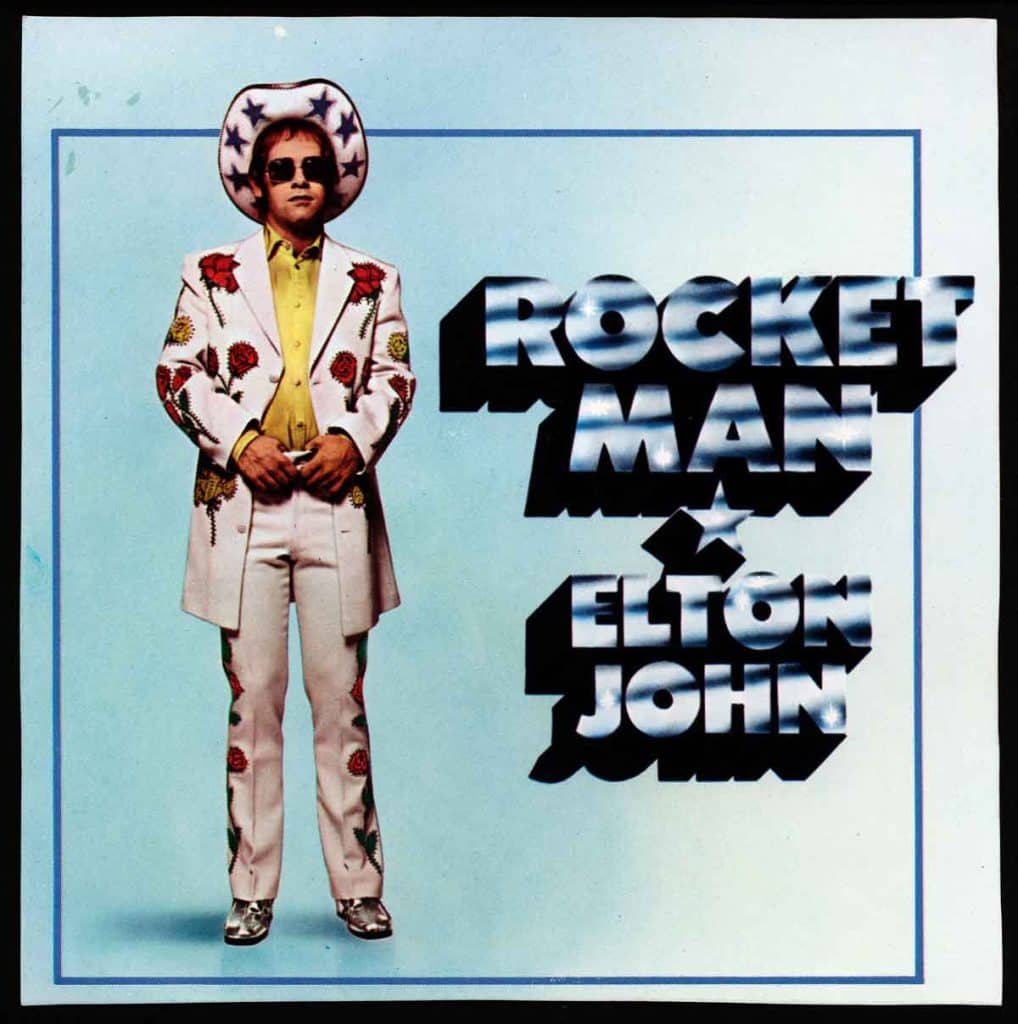
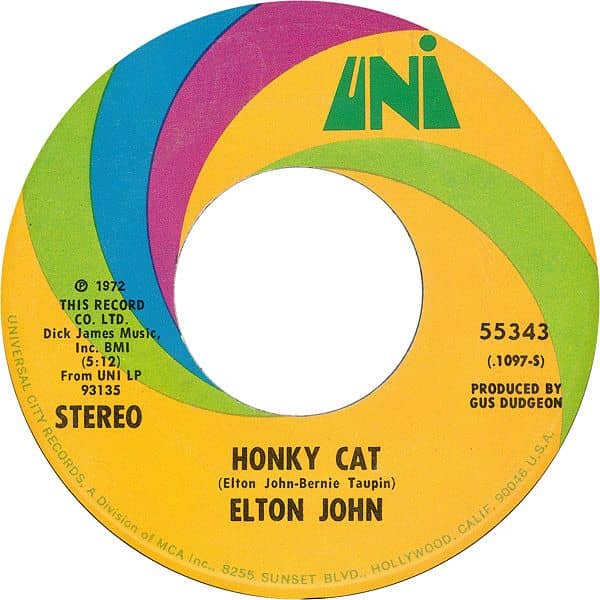
US Singles
Rocket Man b/w Susie (Dramas)
Released on April 17, 1972, on UNI. Debuted on Billboard Hot 100 on May 6, peaking at No. 6 on July 15 and staying on the chart for 15 weeks. Elton’s fourth appearance on the Billboard Adult Contemporary chart, peaking at No. 39 during a two-week stay. Placed on four other US charts in 2019. Currently at 3x Platinum award status from the RIAA.
Honky Cat b/w Slave
Released on July 31, 1972, on UNI. On Billboard Hot 100 for 10 weeks, starting on August 12, peaking at No. 8 on September 23. Peaked at No. 6 on the Billboard Adult Contemporary chart.
Improves with every listen and shows no sign that John and his cohorts are yet content to rest on their laurels.
